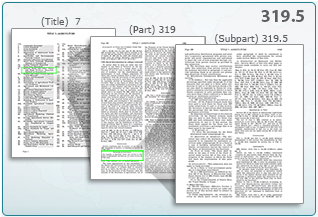Lesson 4: How the Process Works
Topic 1: Receive Request for Market Access
In this topic, you will learn about the step that begins the U.S. market access process: Receiving a request for market access.
Objective:
- Describe APHIS’ requirements governing market access requests for plant and animal products, and identify the organizations that fulfill them.
In lesson 3, we mentioned that requirements for the importation of plants and plant products are found in 7 CFR part 319, and requirements for the importation of animals and animal products are found in 9 CFR parts 93 through 98. APHIS also has requirements that apply to market access requests for animals, plants, and their products.
For plants and plant products, market access requirements are found in 7 CFR 319.5. 
The regulations in § 319.5 set out the procedures for submitting requests and supporting information which APHIS needs to complete the risk analysis process. Supporting information required in § 319.5 is consistent with relevant IPPC standards. APHIS requests information such as:
- The party that is requesting market access
- Information about the commodity to be imported
- Shipping information, including projected volume of importation and method of shipping
- A description of pests and diseases associated with the commodity
- Risk mitigation or management strategies
- Additional information needed, as determined by APHIS, to complete a pest risk analysis in accordance with international standards
For example, a country that wishes to export apples to the United States would specify whether the request covers all apples or just certain varieties. The country would also have to identify pests that are associated with the apples, such as fruit flies and moths. The request would also identify any mitigations currently being used for reducing the pests. If there are areas within the country that are free of one of the pests or that have a low prevalence of one of the pests, the request can identify those areas as well. APHIS could then adjust its mitigations for apples from such areas of the country accordingly. The request would describe how the product is processed, packed, and shipped. For example, the shipping information could indicate that cold treatment for fruit flies is possible because the fruit would be shipped in refrigerated containers or stored for long periods in refrigerated warehouses. The exporting country could also discuss pests of apples that are in the country but not associated with apples produced for commercial markets, since most fruits and vegetables imported into the United States must be imported in commercial consignments.
PPQ has created a website that provides stakeholders with information about the commodity import approval process for plants and plant products, including fruits, vegetables, plants for planting, cut flowers, wood, and wood products. The website describes each major step in the commodity import approval process, including a general description of the following: determination of the import status of a commodity, submission of a request by an NPPO, beginning and drafting of risk assessment and risk management documents, completion of an environmental review, and publication and implementation of new requirements, as applicable. Users can also use the website to track the status of an individual market access request as it goes through the commodity import approval process. The website is available at http://www.aphis.usda.gov/import_export/plants/plant_imports/process/.
Countries can request a change in the animal disease status of a region in accordance with 9 CFR part 92. This part requires countries to submit information about the following:
- The scope of the evaluation being requested
- Veterinary control and supervision within the country
- Disease history and vaccination practices
- Livestock demographics and traceability
- Epidemiological separation from potential sources of infection
- Surveillance
- Diagnostic laboratory capabilities
- Emergency preparedness and response
This information allows APHIS to conduct a risk assessment to determine the country’s status.
APHIS’ regulations also include commodity-based requirements that allow for the importation of a variety of products from regions not considered free of diseases of concern. These requirements are contained largely in 9 CFR part 94. More information regarding these requirements or regarding requests for approval of new requirements can be found on the APHIS animal import website at http://www.aphis.usda.gov/import_export/animals/animal_import/animal_imports.shtml.
For both plant- and animal-related market access requests, the request must come from the government of the country requesting market access. In practice, producers or exporters of agricultural goods are the driving forces behind many market access requests. The government works with the producers to gather information about the commodity for which access is requested and to determine what mitigation strategies might be practical. Only the governmental authorities for plant health (the NPPO) or for animal health (the competent veterinary authority) can supply much of the information APHIS needs to evaluate market access requests.
In this topic, you learned about how APHIS receives market access requests and the requirements that apply to such requests.
To continue, select Topic 2 from the Topics menu above or click here.